Antineoplastics
Antimetabolites
Methotrexate
Pure As Gold: Purines Adenine and Guanine
Pyrimidine = CUT: Cytosine, Uracil, Thymine
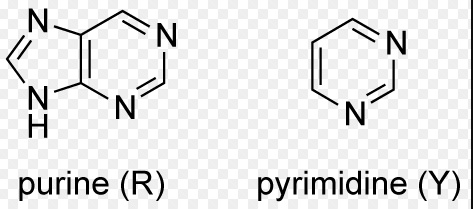
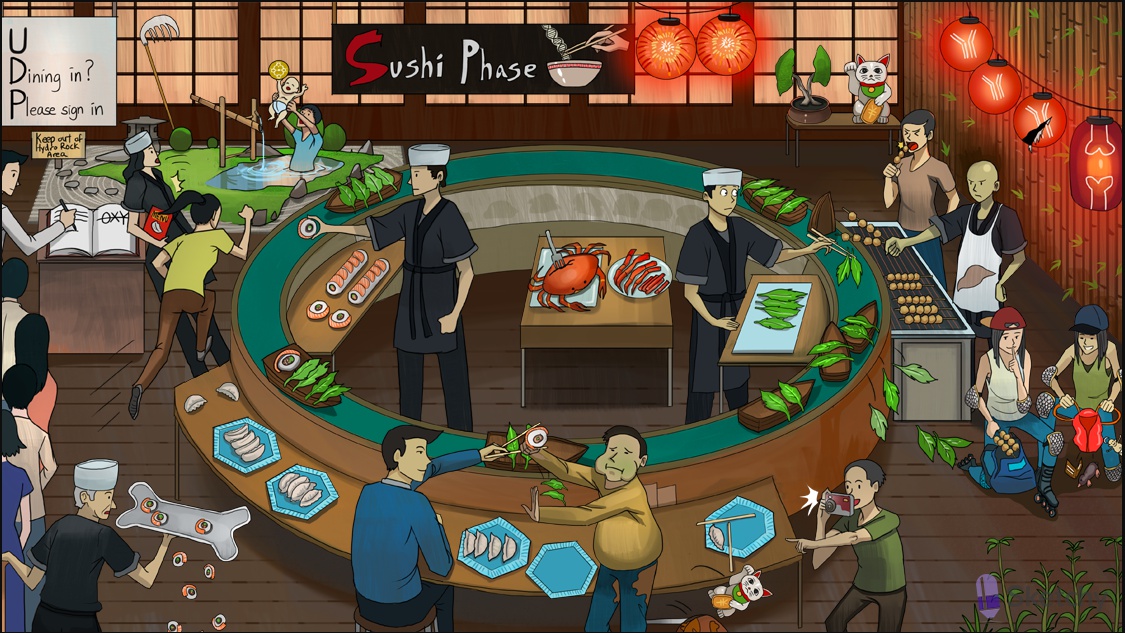
Hexagonal pyrimidine (T, C, U) shape: methotrexate, 5-fluorouracil, and hydroxyurea block synthesis of thymidine (pyrimidine nucleoside)
Blocking DNA: inhibition of thymidine synthesis (by MTX, 5-FU, and hydroxyurea) inhibits DNA synthesis

Sushi phase: antimetabolites (e.g. MTX and 5-FU) and hydroxyurea block the S phase of the cell cycle (DNA synthesis)

Dumplings: deoxyuridine monophosphate (dUMP - precursor to dTMP)
Dumpling with "T" shaped chopsticks: deoxythymidine monophosphate (dTMP)
"C" sushi on a bed of 4 leaves: methylated tetrahydrofolate (N5,N10 Methylenetetrahydrofolate)
Transferring "C" sushi: thymidylate synthase (catalyzes the conversion of methylated THF -> DHF and the methylation of dUMP -> dTMP)
2 leaves: dihydrofolate (DHF)
Adding 2 leaves: dihydrofolate reductase (reduces DHF back to THF)
4 leaves: tetrahydrofolate (THF)
Adding "C" sushi: THF is re-methylated to continue cycle
Methotrexate

Blocked leaf chef: MTX irreversibly blocks dihydrofolate reductase (inhibits synthesis of THF)
Meat stix: methotrexate (MTX - cytotoxic folate analog)

Cracked cancer crab: MTX treats a range of malignancies (e.g. leukemias, lymphomas, breast cancer, head and neck cancer, and lung cancer)
Emptying uterus bag: MTX (with misoprostol) can be used as an abortifacient
Ectopic key chain: MTX treats ectopic pregnancy
Dumping mole: MTX treats invasive molar pregnancy, trophoblastic tumors, and choriocarcinoma
Silvery scale kneepads: MTX treats psoriasis
Rheumatoid lantern with flame for inflammation: MTX is a first line treatment for rheumatoid arthritis (disease modifying antirheumatic drug - DMARD)
Torn antibody: MTX is useful for immunosuppressive therapy (e.g. treatment of IBD, SLE, vasculitis, dermatomyositis)

Buildup of 2 leaf boats: inhibition dihydrofolate reductase (by MTX) causes increased levels of DHF
Falling foliage: MTX can cause folate deficiency
Blasting fireworks: MTX can cause megaloblastic anemia (due to folate deficiency)
Fibrotic lung bonsai: MTX can cause pulmonary fibrosis (restrictive lung disease)
Liver spot: MTX can cause hepatotoxicity
Bald: MTX can cause alopecia
Poking mouth: MTX can cause mucositis
Depleted bone pan: MTX, 5-FU and hydroxyurea can cause myelosuppression and pancytopenia
Immunosuppressed cane: MTX, 5-FU and hydroxyurea can cause immunosuppression and increased risk of infection
Leucovorin

Lucky feline: leucovorin (folinic acid) therapy can reverse the toxic effects of MTX ("leucovorin rescue"). Same as THF, does not require DHF reductase, replaces methotrexate inside cells
5-FU

Full guy: 5-fluorouracil (5-FU - a cytotoxic pyrimidine analog)
Full guy binding carbon donator: 5-FU complexes with THF and inhibits thymidylate synthase (block thymidine production from dUMP to dTMP)]

Cracked cancer crab: 5-FU has activity against many solid tumors (e.g. colorectal, breast, head and neck, liver, pancreas, and basal cell cancers)

Buildup of dumpling plates: inhibition of thymidylate synthase (by 5-FU) causes increased levels of dUMP
Stained pants: 5-FU can cause diarrhea by killing rapidly dividing GI epithelium
Sensitive photos: 5-FU causes a variety of cutaneous complications (e.g. including photosensitivity and hyperpigmentation reactions
Knocked over lucky feline: leucovorin (folinic acid) does not prevent toxicities of 5-FU
Depleted bone pan: MTX, 5-FU and hydroxyurea can cause myelosuppression and pancytopenia
Immunosuppressed cane: MTX, 5-FU and hydroxyurea can cause immunosuppression and increased risk of infection
Hydroxyurea

U-D-P: uridine diphosphate (UDP - precursor to pyrimidine nucleosides)
Crossed out OXY: ribonucleotide reductase (converts UDP -> deoxy-UDP), then converted to dUMP

Hydro-rock area: hydroxyurea (ribonucleotide reductase inhibitor)
Inhibited wait list waitress: hydroxyurea inhibits ribonucleotide reductase (blocked thymidine synthesis)

Cracked crab: hydroxyurea has activity against solid and hematologic malignancies (e.g. AML, CML, and head and neck cancer)
Zen sickle: hydroxyurea reduces veno-occlusive crises in sickle cell anemia
Raised baby with hemoglobin coin: hydroxyurea increases fetal hemoglobin (HbF) levels (protects against polymerization of mutated HbS)

Depleted bone pan: MTX, 5-FU and hydroxyurea can cause myelosuppression and pancytopenia
Immunosuppressed cane: MTX, 5-FU and hydroxyurea can cause immunosuppression and increased risk of infection
Azathioprine

Pentagon pedestal with 3 P hammers: phosphoribosyl pyrophosphate (PRPP) (5 point ribose sugar with 3 phosphate) → precursor to IMP
Gargoyle imp: inosine monophosphate (IMP) intermediate purine nucleotide → precursor to AMP and GMP)
“Pure As Gold”: AMP and GMP are purine nucleotides
GruMPy statue: guanosine monophosphate (GMP - purine nucleotide)
grAMPs statue: adenosine monophosphate (AMP - purine nucleotide)

Aza-meralda: azathioprine (AZA - prodrug of the cytotoxic purine analog 6- mercaptopurine)
CAPTured gypsy: 6-mercaptopurine (6-MP - cytotoxic purine analog)
HiGh PRiesT: Hypoxanthine-guanine phosphoribosyl transferase (HGPRT)
HiGh PRiesT aggrevating captive: HGPRT activates 6-MP
Captive toppling imp: AZA/6-MP blocks synthesis of IMP → decreased purine nucleotide synthesis → blocked DNA and RNA synthesis
“Stairs out”: AZA/6-MP blocks the S phase of the cell cycle (DNA synthesis)

Cracked antibody archers and T knights: 6-MP treats hematologic malignancies (e.g. ALL)
Torn antibody: AZA/6-MP is useful for immunosuppressive therapy (e.g. treatment of graft rejection, SLE, autoimmune hemolytic anemia)
Rheumatoid lantern: AZA/6-MP can be used to treat refractory rheumatoid arthritis (disease modifying antirheumatic drug - DMARD)
Inflamed colonic lanterns: AZA/6-MP can be used to treat inflammatory bowel disease (i.e. crohn's disease, ulcerative colitis)

Depleted birdseed marrow: AZA/6-MP and mycophenolate can cause myelosuppression
Immunosuppressed cane: AZA/6-MP can cause immunosuppression and increased risk of infection
Squeezed pancreas sponge: AZA/6-MP can cause pancreatitis
Liver stain: AZA/6-MP can cause hepatitis

Pure nuns: allopurinol is a xanthine oxidase (XO) inhibitor
XO breaks down 6-MP
Collection of purine beads: inhibition of XO increases levels of purine analogs (e.g. 6-MP) → increased risk of side effects

Quasi-mofetil: mycophenolate mofetil (IMP dehydrogenase inhibitor)
Quasi-mofetil topples GruMPy statue: mycophenolate inhibits IMP dehydrogenase → decreased GMP synthesis → decreased lymphocyte proliferation
Torn antibody: mycophenolate is useful for immunosuppressive therapy (e.g. treatment of graft rejection, SLE, myasthenia gravis)
Rheumatoid lantern: mycophenolate can be used to treat rheumatoid arthritis (disease modifying antirheumatic drug - DMARD)

Nauseated: mycophenolate can cause GI distress (nausea, diarrhea, cramping)
Depleted birdseed marrow: AZA/6-MP and mycophenolate can cause myelosuppression
Immunosuppressed cane: mycophenolate can cause immunosuppression and increased risk of infection
Cladribine

Clad in bearskins: cladribine (cytotoxic purine analog)
Purine shaped hammer: cladribine is a purine analog
Cracked replication fork: cladribine, cytarabine, and gemcitabine inhibit DNA polymerase
Stone Phase: antimetabolites (e.g. cladribine, cytarabine, gemcitabine) inhibit the S phase of the cell cycle (DNA synthesis)

Hairy caveman: cladribine treats hairy cell leukemia

Broken marrow: cladribine, cytarabine, and gemcitabine can cause myelosuppression
Immunosuppressed cane: cladribine, cytarabine, and gemcitabine can cause immunosuppression and increased risk of infection

Saber toothed tiger: cytarabine (cytotoxic pyrimidine analog)
Pyrimidine shapes: cytarabine and gemcitabine are pyrimidine analogs
Cracked replication fork: cladribine, cytarabine, and gemcitabine inhibit DNA polymerase
Stone Phase: antimetabolites (e.g. cladribine, cytarabine, gemcitabine) inhibit the S phase of the cell cycle (DNA synthesis)

Gems inside geode: gemcitabine (cytotoxic pyrimidine analog)
Pyrimidine shapes: cytarabine and gemcitabine are pyrimidine analogs
Cracked replication fork: cladribine, cytarabine, and gemcitabine inhibit DNA polymerase
Stone Phase: antimetabolites (e.g. cladribine, cytarabine, gemcitabine) inhibit the S phase of the cell cycle (DNA synthesis)

Scratched out antibody archers and T-cell swordsmen: cytarabine is only active against hematologic malignancies (e.g. AML, non-Hodgkin lymphoma)

Cracked crab fossil on solid rocks: gemcitabine is active against both hematologic malignancies and solid tumors
DNA Antimetabolites
Cyclophosphamide, busulfan, nitrosoureas

alkylating odyssy
Cyclops polyphemus: cyclophosphamide (cytotoxic alkylating agent)
Cross-linking ankle chains: alkylating agents donate an alkyl group → DNA cross-links (cell cycle NONspecific), N7

Torn cancer crab: cyclophosphamide treats many hematologic and solid malignancies (e.g. leukemias and lymphomas, breast cancer, ovarian cancer)
Torn antibody: cyclophosphamide is a potent immunosuppressive therapy (e.g. treatment of nephrotic syndrome, nephritic syndrome, vasculitis, autoimmune hemolytic anemia)

Activating chrome bumper: cyclophosphamide is ACTIVATED by hepatic cytochrome P450 enzymes
Broken marrow: cyclophosphamide can cause myelosuppression
Red urine: cyclophosphamide can cause hemorrhagic cystitis
Protective maze: coadministration of 2-mercaptoethanesulfonate (MESNA) prevents hemorrhagic cystitis. MESNA donates thiol group that inactivates toxic metabolite
Cancer crab belt buckle: cyclophosphamide increases risk of bladder cancer (high grade transitional cell carcinoma)
Inappropriately wet head: cyclophosphamide can cause hyponatremia due to SIADH
Dried up fruit tree: cyclophosphamide can cause infertility and premature menopause

Beautiful sirens: busulfan (cytotoxic alkylating agent)
Severely depleted marrow: busulfan is useful as a conditioning agent prior to bone marrow transplantation
Fibrotic lung pattern: busulfan can cause lung toxicity (e.g. acute lung injury, interstitial fibrosis, alveolar hemorrhage)
Beautiful TAN sirens: busulfan can cause a hyperpigmentation reaction (“busulfan tan”)

Centaurs: nitrosoureas (cytotoxic alkylating agents)
Mustang: “-mustine” suffix of nitrosoureas (e.g. carmustine, lomustine)
Striped zebra centaur: streptozotocin (nitrosourea - cytotoxic alkylating agent)
Brain tree: nitrosoureas are highly lipophilic → cross BBB → treat brain tumors (e.g. glioblastoma multiform)
Dizzy centaur: nitrosoureas can cause neurotoxicity (e.g. convulsions, dizziness, ataxia)
Cisplatin
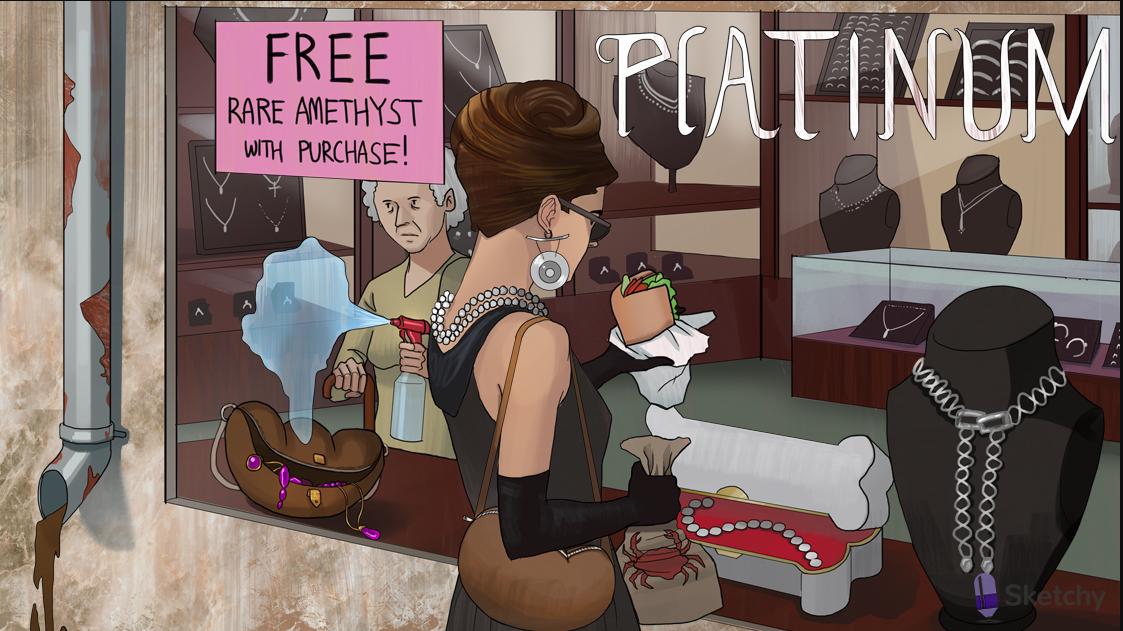
Platinum: cisplatin, carboplatin, oxaliplatin (cytotoxic platinum analogs)
Cross-linked helix necklace: platinum analogs bind DNA and form intrastrand and interstrand cross-links, N7
Crumpled crab: platinum analogs treat various solid malignancies (e.g. non-small cell lung cancer, small cell lung cancer, testicular cancer, ovarian cancer, bladder cancer)

Ototoxic earrings: platinum analogs can cause ototoxicity → sensorineural hearing loss, tinnitus (especially cisplatin)
Neuropathic gloves: platinum analogs can cause neurotoxicity → peripheral neuropathy (especially cisplatin)
Nephrotoxic purse: platinum analogs can cause nephrotoxicity → acute kidney injury (especially cisplatin)
Muddy drain tube: platinum analogs can cause acute tubular necrosis (ATN - muddy brown casts)
Amethyst: amifostine (an organic thiophosphate) can prevent cisplatin-induced nephrotoxicity
“Free, rare”: amifostine scavenges free radicals produced by cisplatin in the kidney
Saline fluids: IV saline diuresis prevents cisplatin-induced nephrotoxicity
Depleted bone jewelry box: platinum analogs can cause myelosuppression (especially carboplatin)
Immunosuppressed cane: platinum analogs can cause immunosuppression and increased risk of infection (especially carboplatin)
Bleomycin
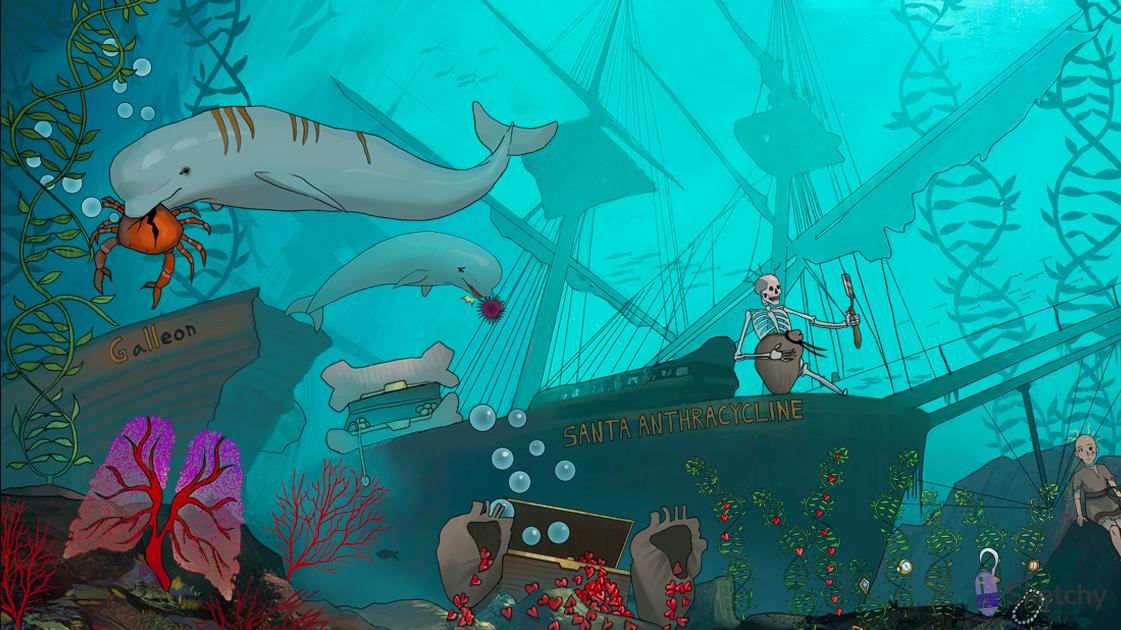
Beluga whale: bleomycin (antitumor antibiotic)
Oxide bubbles: bleomycin binds DNA and produces free radicals (superoxide, hydroxide)
Broken double helix kelp: free radicals produced by bleomycin cause single and double strand breaks in DNA
Galleon: bleomycin blocks the G2 phase of the cell cycle
Cracked anticancer crab: bleomycin treats many hematologic and solid malignancies (e.g. Hodgkin and Non-hodgkin lymphoma, germ cell tumors, squamous cell carcinoma of the skin, cervix, and vulva)

Lung coral: bleomycin can cause pulmonary toxicity (e.g. pneumonitis, pulmonary infiltrates)
Hyperpigmented striae: bleomycin can cause skin toxicity (e.g. rash, exfoliation, hyperpigmentation, atrophic striae)
Poking mouth: bleomycin (and anthracyclines) can cause mucositis and stomatitis
Bald beluga: bleomycin can cause alopecia

Santa Anthracycline: anthracyclines (antitumor antibiotics)
Rubies: “-rubicin” suffix of anthracyclines (e.g. doxorubicin, daunorubicin)
Oxide bubbles: anthracyclines produce free radicals (e.g. superoxide, hydroxide)
Rubies inserting into helical seaweed: anthracyclines (e.g. doxorubicin) intercalate in DNA → block DNA and RNA synthesis
Cracked cancer crab: anthracyclines (e.g. doxorubicin) treats a broad range of solid and hematologic malignancies

Dilated heart ruby sacks: anthracyclines (e.g. doxorubicin) can cause cardiotoxicity (e.g. dilated cardiomyopathy). Free radicals
Chelating the heart sack on deck: dexrazoxane (iron chelator) prevents anthracycline-induced cardiotoxicity
Up on deck with razor: dexrazoxane (iron chelator)
Depleted bone chest: anthracyclines (e.g. doxorubicin) and actinomycin D can cause myelosuppression
Bald pirate: anthracyclines (e.g. doxorubicin) can cause alopecia

Doll artifact: actinomycin D (antitumor antibiotic)
Artifacts inserting into helical seaweed: actinomycin D intercalates in DNA → block DNA and RNA synthesis
Child’s artifact: actinomycin D treats numerous pediatric malignancies (e.g. Wilms tumor, Ewing sarcoma, rhabdomyosarcoma)
Bald doll: actinomycin D can cause alopecia
Etoposides
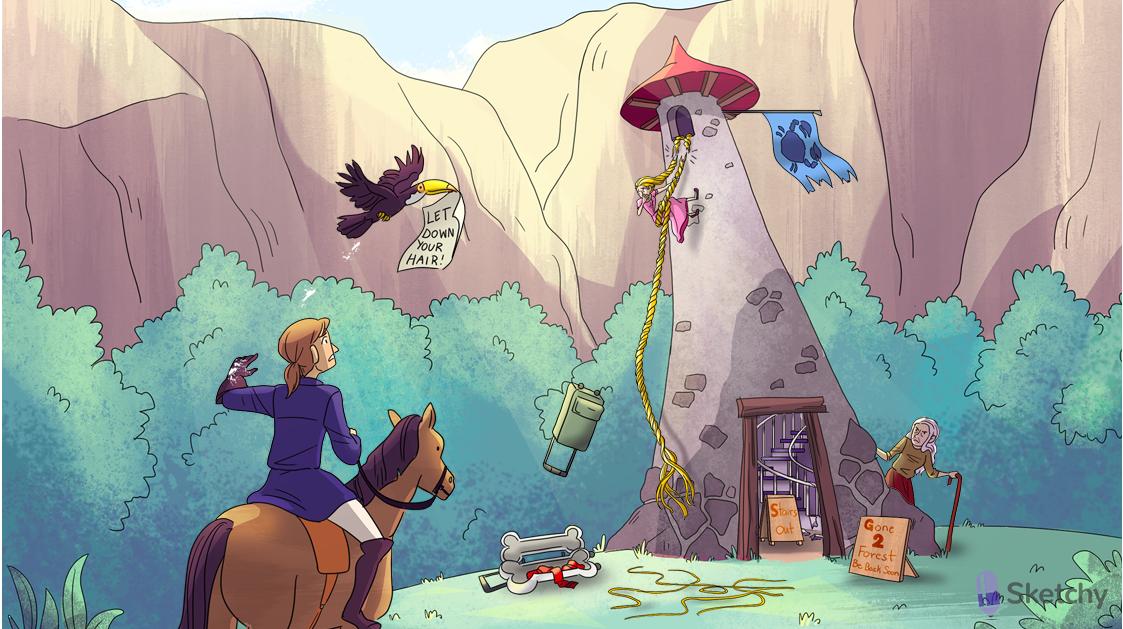
Side of the tower: etoposide and teniposide (topoisomerase II inhibitors)
Unwinding strands: topoisomerases relieve DNA supercoiling that occurs during DNA replication
Grasping 2 strands: etoposide and teniposide inhibit topoisomerase II (double stranded breaks to relieve supercoiling)
Both strands breaking: etoposide and teniposide prevent religation of the double strand break induced by topoisomerase II
“Stairs out”: topoisomerase inhibitors block the S phase of the cell cycle (DNA synthesis)
“Gone 2 forest”: topoisomerase inhibitors block the G2 phase of the cell cycle (double check and repair)
Ripped cancer crab: etoposide and teniposide treat many solid and hematological malignancies (e.g. testicular cancer, small cell lung cancer, Hodgkin and non-Hodgkin lymphoma)

Spilling bone luggage: topoisomerase inhibitors can cause myelosuppression
Immunosuppressed cane: topoisomerase inhibitors can cause immunosuppression
Losing hair: topoisomerase inhibitors can cause alopecia

Toucan: topotecan and irinotecan (topoisomerase I inhibitors)
Single ponytail strand: topotecan and irinotecan inhibit topoisomerase I (single strand nick to relieve supercoiling)
Loose bird stool: topotecan and irinotecan can cause severe diarrhea

Vincristine

Christine in vines: vincristine (cytotoxic vinca alkaloid)
Breaking spindle vines: vinca alkaloids (e.g. vincristine, vinblastine) inhibit microtubule production and mitotic spindle assembly
Blasting vines: vinblastine (cytotoxic vinca alkaloid)
“M” shape in vines: drugs that affect microtubule function (e.g. vinca alkaloids, taxanes) block the M phase of the cell cycle (mitosis)
Tarzan: taxanes (e.g. paclitaxel, docetaxel, cabazitaxel - cytotoxic plant alkaloids)
Stabilizing the vine: taxanes enhance microtubule production and prevent their degradation → improper mitotic spindle function

Cracked cancer crab: vinca alkaloids treat many hematologic and solid malignancies (e.g. leukemias, lymphomas, pediatric tumors, breast cancer, and germ cell cancer)
Neuropathic stockings and gloves: vincristine can cause neurotoxicity (e.g. peripheral sensory neuropathy)
Plunger: vincristine can cause autonomic dysfunction (e.g. paralytic ileus, constipation)
Bald: vinca alkaloids (e.g. vincristine, vinblastine) can cause alopecia
Broken marrow: drugs that affect microtubule function (e.g. vinca alkaloids, taxanes) can cause myelosuppression (especially vinblastine)
Bald: taxanes (e.g. paclitaxel) can cause alopecia
Neuropathic glove: taxanes can cause neurotoxicity (e.g. peripheral sensory neuropathy)
Kinase Inhibitors and Antibodies
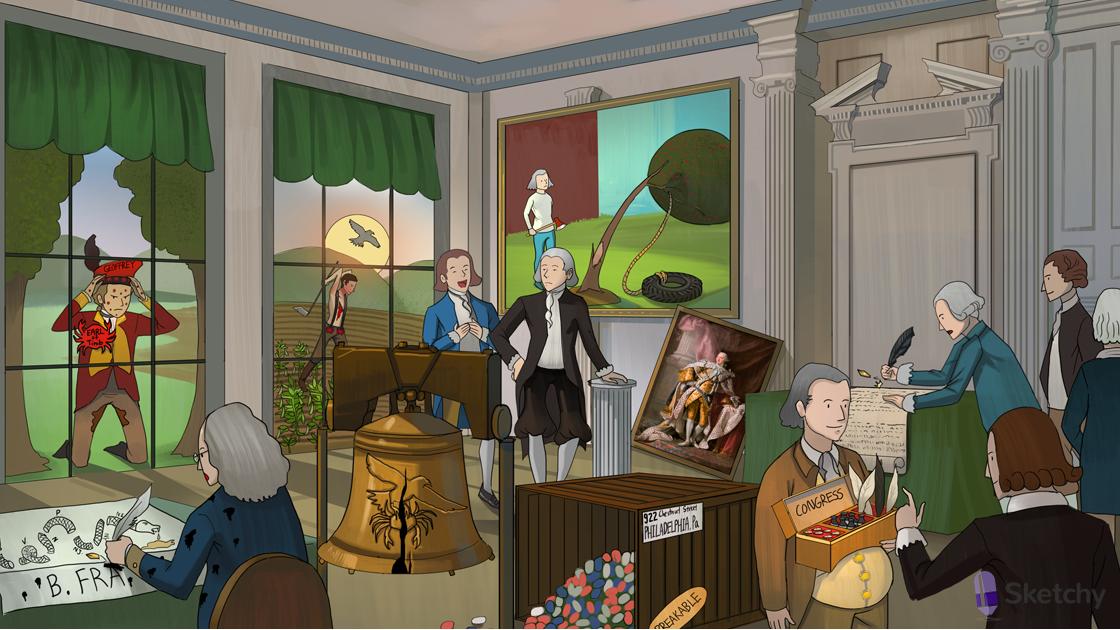
Broken nib: “-nib” suffix of small molecule kinase inhibitors (e.g. imatinib, erlotinib, vemurafenib)
Inhibited tire swing: tyrosine kinase inhibitors (“-tinib” e.g. imatinib, erlotinib, sunitinib)
Imitating: imatinib (small molecule tyrosine kinase inhibitor)
British Earl: erlotinib (small molecule tyrosine kinase inhibitor)
Rising sun: sunitinib (a small molecule tyrosine kinase inhibitor)
Soaring eagle: sorafenib (a small molecule tyrosine kinase inhibitor)
Venom: vemurafenib (a small molecule kinase inhibitor)
Cracked crab: small molecule kinase inhibitors treat a variety of hematologic and solid malignancies (e.g. imatinib treats CML)

Imitating: imatinib (small molecule tyrosine kinase inhibitor)
Cracked crab: small molecule kinase inhibitors treat a variety of hematologic and solid malignancies (e.g. imatinib treats CML)
Copious pink, white, and blue granules: chronic myeloid leukemia (CML) (increased levels of mature granulocytes - eosinophils, neutrophils, basophils)
BREAKABLE: imatinib blocks the tyrosine kinase domain of the BCR/ABL fusion protein (in CML)
Philadelphia, Pa: translocation between chromosomes 9 and 22 → BCR/ABL oncogene on chromosome 22 (Philadelphia chromosome)
Congress kit: imatinib blocks the c-kit tyrosine kinase (in GIST)
Crab buttons on belly: c-kit tyrosine kinase is found in gastrointestinal stromal tumors (GIST)

Baggy pantaloons: imatinib can cause fluid retention → ankle and periorbital edema

British Earl: erlotinib (small molecule tyrosine kinase inhibitor)
Earl Geoffrey: erlotinib blocks the epidermal growth factor receptor (EGFR) tyrosine kinase
Big lapel with crab badge: erlotinib treats solid tumors with EGFR overexpression (e.g. non-small cell lung cancer - NSCLC)
Spotty rash: erlotinib can cause a papulopustular acneiform rash
Muddy pantaloons: erlotinib can cause diarrhea

Rising sun: sunitinib (a small molecule tyrosine kinase inhibitor)
Soaring eagle: sorafenib (a small molecule tyrosine kinase inhibitor)
Inhibiting vegetables: sunitinib and sorafenib inhibit the vascular endothelial growth factor receptor (VEGFR) tyrosine kinase
Flank crab buckles: sunitinib and sorafenib treat cancer with VEGFR overexpression (e.g. renal cell carcinoma)
Callused and sunburned: sunitinib and sorafenib can cause hyperkeratosis and skin
rashes
Bleeding wound: VEGF-targeted therapies (e.g. sunitinib, sorafenib) are associated with
an increased risk of hemorrhage

Venom: vemurafenib (a small molecule kinase inhibitor)
B. Fra: vemurafenib blocks B-Raf kinase
Disseminated ink: vemurafenib treats V600E BRAF positive malignant melanoma
Rituximab
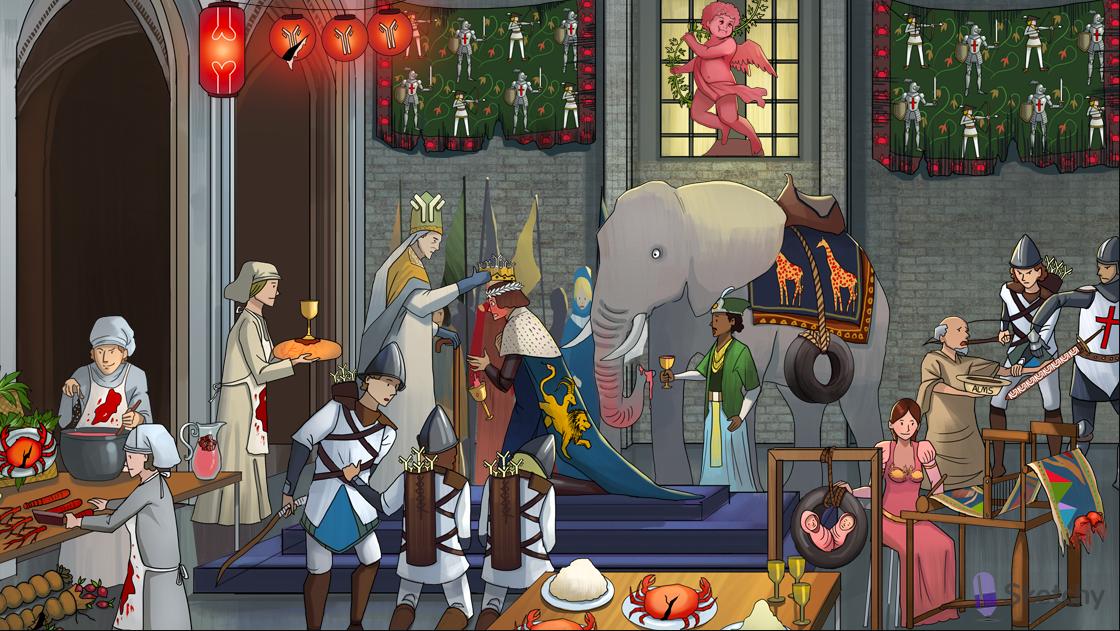
mab = antibody, monoclonal
chimeric: still retains protein fragments from other animals
monoclonal = from same cell line, target same antigen
Tusks: cetuximab (monoclonal antitumor antibody)
Coronation ritual: rituximab (antitumor monoclonal antibody)
Beverage lady: bevacizumab (monoclonal antitumor antibody)
Alms: alemtuzumab (monoclonal antitumor antibody)
Tapestry weaver: trastuzumab (monoclonal antitumor antibody)

Coronation ritual: rituximab (antitumor monoclonal antibody)
Chimera sigil: rituximab and cetuximab are chimeric monoclonal antibodies (IgG)
Pulling down antibody archer: rituximab depletes B cells (binds CD20), ADCC, treats CD20 positive non-hodgkins lymphoma
Grabbing “XX” straps: rituximab binds CD20 on B-cells
Chronic, worn out tapestry with antibody archers and T knights: rituximab treats chronic lymphocytic leukemia (CLL)
Rheumatic lantern: rituximab treats rheumatoid arthritis (disease modifying antirheumatic drug - DMARD)
Torn antibody: Rituximab is useful for immunosuppressive therapy (e.g. microscopic polyangiitis, Wegener’s granulomatosis)

Immunosuppressed cane: Rituximab can cause immunosuppression, neutropenia, and increased risk of infection
White laurel leaves: rituximab may be associated with a higher risk of progressive multifocal leukoencephalopathy (PML)
Swollen cherub with ivy: monoclonal antibodies can cause an infusion reaction (e.g. headache, fever, skin rash, pruritus, dyspnea, hypotension) (cytokine release from B cells)
Delayed onset poisoning: chimeric antibodies (e.g. rituximab) can cause serum sickness (e.g. fever, rash, arthralgia within 7-10 days) (deposition of immune complex, type 3) (immune system targeting mouse of antibody)

Tusks: cetuximab (monoclonal antitumor antibody)
Chimera sigil: rituximab and cetuximab are chimeric monoclonal antibodies (IgG)
Giraffe: cetuximab binds the epidermal growth factor receptor (EGFR)
Tire swing: EGFR is a receptor tyrosine kinase
Cracked crab: cetuximab treats solid tumors (e.g. colorectal cancer, squamous cell carcinoma)
Red spots: cetuximab can cause a papulopustular acneiform rash (EGFR expressed on skin)
Delayed onset poisoning: chimeric antibodies (rarely cetuximab) can cause serum sickness (e.g. fever, rash, arthralgia within 7-10 days)

Beverage lady: bevacizumab (monoclonal antitumor antibody)
Chopped vegetables: bevacizumab binds VEGF
Chopping vessels: bevacizumab inhibits growth of blood vessels in tumors (binds VEGF) (inhibit wound healing)
Cracked crab: bevacizumab treats metastatic tumors (e.g. colorectal cancer, lung cancer)
Wet center of retina pillow: bevacizumab treats wet macular degeneration
Blood spatter: bevacizumab can cause bleeding
Ice clots: bevacizumab increases the risk for thrombotic events, TIA, strokes, angina
Perforating colon bag: bevacizumab can cause GI perforation (sudden abdominal pain)

Alms: alemtuzumab (monoclonal antitumor antibody)
Pulling down antibody archer and T knight: alemtuzumab depletes B and T cells (binds CD52)
52 pattern: alemtuzumab binds CD52 on B and T cells, ADCC
Chronic tapestry with antibody archers and T knights: alemtuzumab treats chronic lymphocytic leukemia (CLL)

Tapestry weaver: trastuzumab (monoclonal antitumor antibody)
Her 2 babies: trastuzumab binds epidermal growth factor receptor 2 (HER2, c-erbB2)
Tire swing: HER2 is a receptor tyrosine kinase
Crab bra: trastuzumab treats HER2 positive breast cancer
Unraveling heart: trastuzumab can cause cardiotoxicity (e.g. decreased LVEF, heart failure)
Last updated
Was this helpful?